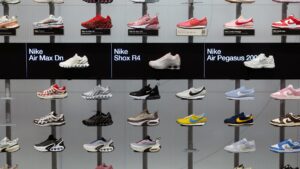Nike’s Price Increases: What You Need to Know
As global markets buckle under the weight of U.S. tariffs, Nike is preparing to raise prices across a range of its footwear and apparel. This strategic move, aimed at offsetting increasing production costs, is set to take effect within days and has significant implications for consumers and the broader retail landscape.
The Price Hike Breakdown
According to industry insiders, Nike plans to implement price increases starting this June, with early changes visible on store shelves much sooner. Here’s a breakdown of what to expect:
- Adult Apparel and Gear: Prices will rise between $2 and $10.
- Footwear:
- Sneakers priced between $100 and $150 will see a $5 increase.
- Those above $150 will experience a $10 hike.
Fortunately, items specifically for children and products priced under $100 will not see any changes, as Nike remains aware of the financial burdens many families are facing, particularly during the back-to-school shopping season.
Strategic Insights from Extreme Investor Network
While raising prices is a common practice for retailers, Nike’s current circumstances are unique and reflective of a larger trend in the industry. With nearly 50% of its footwear manufacturing based in China and Vietnam—countries now facing steep tariffs—Nike’s pricing strategy serves as a barometer for market conditions.
Why this Matters: Understanding these price hikes is crucial not only for consumers but also for investors tracking Nike’s market performance. As tariffs begin to bite deeper into profit margins, it’s likely that this pricing adjustment could be a pivotal moment in how Nike navigates its current business transition.
The Bigger Picture: Tariffs and Profit Margins
U.S. tariffs, including a significant 30% levy on Chinese imports and a 10% duty on Vietnamese goods, are poised to affect Nike’s profit margins. Notably, these tariffs arrived just as the company was grappling with challenges in moving inventory, often resorting to discounts that gnaw away at profitability.
Recent commentary from Nike acknowledges the necessity of regular price evaluations within its seasonal planning. However, the corporation has remained somewhat reticent about explicitly tying these hikes to the incoming tariffs, which suggests a complex navigation of brand loyalty against economic pressure.
The Road Ahead: Market Reactions and Consumer Behavior
While it’s clear that the price hikes will reflect the Manufacturer’s Suggested Retail Prices (MSRP) in Nike stores and online, the implications extend beyond mere numbers. Retail partners like Dick’s Sporting Goods and Foot Locker will likely reflect these increases, though how that will be implemented is still under wraps.
Conclusion
The dynamic between pricing strategies and market conditions underscores the evolving landscape of the retail industry. As Nike adapts to these challenges, consumers need to remain informed about their purchasing decisions. For investors, observing how consumer loyalty and market response fluctuate in reaction to these changes will be paramount.
At Extreme Investor Network, we continue to monitor these developments closely, providing you with unique insights that help you make informed investment choices in a rapidly changing environment. Stay tuned to our platform for ongoing updates and analyses on how global economic factors are reshaping the business landscape, and what that means for your investment portfolio.

